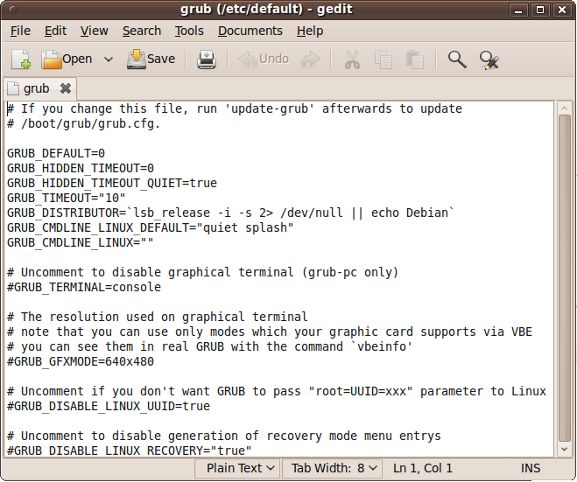

The example menu.lst has commands for installing operating systems from mach to Windows, and it even has an entry that installs grub on the system and another that changes the menu colors. Tip for newcomers from Windows: Linux terminal has Edit-Copy functionality, so you can easily copy/paste UUID to your menu.lst. When booting via the Grub4dos MBR the boot guidd configuration files do not have to be on the boot drive and can be moved to any local disk, as long as the file system is supported. A menu.lst file is basically just the same list of commands youd use at the grub> prompt, except that the boot command is not included. grub2-mkconfig -o /boot/efi/EFI/redhat/grub.cfg). 1) Convert the partition number: Linux > Grub4Dos /dev/sda7 > (hd0,6) 2) Find out UUID of boot partition /dev/sda7 - run the following command from the terminal, UUID will be shown in the right column: blkid -o list. Command: cat file Display the contents of the file file. Only necessary if running the fully interactive command-line (it is implicit at the end of a menu entry). Command: boot Boot the OS/chain-loader which has been loaded. title find /boot/grub/menu. See 'Delimitors or comments between titles' in grub4dosreadme.txt. So, if you find yourself banging your head against your desk because the default boot selection never changes despite following all of the advice you've found, see if you might be modifying the wrong grub.cfg file.Īlso worth noting is that if you've completely hosed your grub.cfg file, you can rebuild it with grub2-mkconfig (e.g. Command: blocklist file Print the block list notation of the file file. The above boot command is needed in this case.
GRUB4DOS BOOT COMMANDS MENU FILE ISO
For example, under RedHat, CentOS, and Fedora there is one for legacy boot and one for EFI boot. The Hirens Boot CD contains a Make ISO batch file which uses the following command to create an HBCD ISO called MyHBCD.ISO which has a grub4dos boot loader mkisofs.exe -R -D -J -l -joliet-long -duplicates-once -o MyHBCD.iso -b HBCD/grldr -c HBCD/boot.cat -hide-joliet HBCD/boot.cat -hide HBCD/boot. It's also worth noting that there may be multiple grub.cfg files on your system. the 2nd in the list) run the following command: grub2-set-default 1

Then type the following commands in a terminal. Given that the menu item that you want is number 1 (i.e. one operating system installed, it allows you to select which one to boot. If you omit the argument FILE, then GRUB just unlocks privileged instructions.
GRUB4DOS BOOT COMMANDS MENU FILE PASSWORD
If the password PASSWRD is entered, it loads the FILE as a new config file and restarts the GRUB Stage 2.

Start counting from zero to find the number of the menuentry that you want. If used in the first section of a menu file, disable all interactive editing control (menu entry editor and command line). Step 1: Find the number of your boot selection: ~]# grep "^menuentry" /boot/efi/EFI/redhat/grub.cfg Alternatively, GRUB.EXE can be loaded from another PXE boot loader - e.g. This can be done using the grub command line tools. The Grub4dos file grldr can be used as a Preboot eXecution Environment (PXE) boot file.


 0 kommentar(er)
0 kommentar(er)
